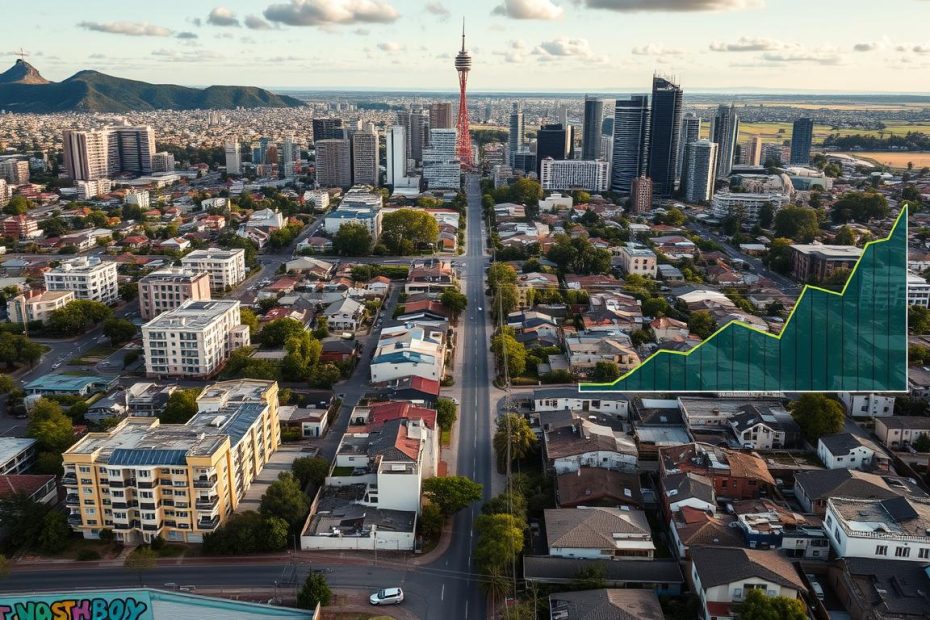In Australia, income inequality is a big issue. It affects the economy and society. It impacts people’s wellbeing and future.
Wages show a big gap between the rich and the poor. High-income earners make nearly three times more than middle-income ones. The lowest earners make six times less than the middle ones.
At work, things are tough for the poor. Only 24% of the lowest earners have jobs. More than half have part-time jobs. High-income earners, on the other hand, have steady jobs.
Investments also show a big gap. The rich earn five times more from investments than the middle class. They earn eight times more than the top 5%.
Social security helps the poor. But, the rich own most of the wealth. High earners have nearly $2 million, while middle earners have $711,000.
Historically, inequality has grown. But, the lowest earners have seen some income growth. Yet, overall inequality has risen.
The Gini coefficient shows how unequal we are. Education might help in the future. But, wage differences are still a big issue.
The Current State of Income Inequality in Australia
Australia’s income inequality is complex, showing differences in many areas. The GINI coefficient is a key tool to measure this. It shows how unequal income is in a country, with higher values meaning more inequality.
Understanding the GINI Coefficient
Australia’s GINI coefficient has changed, showing a detailed view of income inequality. At first, the pandemic made things more equal thanks to government help. But as this help ended, inequality grew again. This measure is crucial for making policies and planning for the economy.
Analysing the Wage Disparity Across Different Income Groups
Wage disparity is a big issue in Australia, affecting different income groups in different ways. The top 10% of households earn much more than the middle and lower ones. This gap shows a bigger wage disparity that affects wages in Australia and the wealth gap.
There are also differences in jobs, hours worked, and the stability of some incomes. This makes things even more complicated.
Household wealth and earnings are linked but complex. Middle-aged and older Australians usually have more wealth. But, the wealthiest households have a big share of national wealth. Wage growth rates also vary, affecting economic disparity in Australia.
Wage inequality is a big challenge. It shows the need for policies to address these economic divides. By changing wage structures and tax policies, Australia can work towards a fairer society. This would help income groups carry their financial burdens more evenly.
Major Sources of Household Income and Their Role in Economic Disparity
In Australia, how households earn money is key to understanding economic issues. It’s important to see how income varies among different groups. This helps us understand the wealth gap and the nation’s economic health.
Wages and Salaries as the Primary Contributor
Most households get their income mainly from wages and salaries, making up about 77% of earnings. This shows how wages affect economic inequality. The rich get more money and benefits, while the poor struggle with low wages.
This difference in earnings is a big reason for income inequality in Australia.
Investments and Superannuation Impacting the Wealth Gap
Investment income and superannuation may not be as big a part of household income as wages. But, they have a big effect on the wealth gap. The rich have better investment chances and super plans, making them more financially secure.
Statistics show the top 20% of earners get more from investments than the middle class. This highlights a clear gap in wealth.
Social Inequality and the Wealth Distribution Landscape
Australia’s wealth shows a big gap between rich and poor. This gap affects many families, making life tough for some. It also damages the country’s social fabric and holds back its people’s growth.
Looking at wealth distribution in Australia, the top 20% own most of the wealth. This includes things like houses, stocks, and retirement savings. This wealth gap makes social inequality worse, affecting more than just money.
This wealth gap hurts not just the poor but also the middle class. It’s important to work on making the economy fairer. This way, everyone can have a chance to be prosperous, not just a few.
Dealing with wealth gaps is urgent. We need policies that fix the problems, not just the symptoms. Changes in taxes, better education, and fair jobs are key steps.
To solve these issues, we must understand why wealth gaps exist. Working together, we can make Australia more equal. This will help everyone, not just the wealthy few.
Income Inequality: A Closer Look at Employment and Unemployment Rates
Australia’s employment rates and unemployment figures show more than just economic health. They also reveal income inequality and job market disparities. Despite a strong employment rate of 77.5% among those aged 15–64 as of July 2023, there are worrying signs. The unemployment rate of 3.7% doesn’t tell the whole story of employment disparity across different income levels.
The underemployment rate of 6.4% shows many people can’t find enough work. This makes income inequality worse. Employment rates also vary greatly among different socio-economic groups. This shows a job market that’s not fair for everyone.
Employment disparities lead to income inequality. Studies show earnings inequality among full-time workers in Australia is increasing. Job security and quality are key factors in this. For example, part-time and casual jobs often pay less and are less stable.
To tackle these issues, we need to understand the Australian job market better. There’s a clear link between unemployment, underemployment, and income inequality. We need policies that increase employment and ensure everyone has access to good jobs. This will help break the cycle of poverty and inequality, leading to a more inclusive economic future in Australia.
Investment Income Disparities and Their Contributions to the Financial Divide
In Australia, the way investment income is spread out shows a big economic imbalance. Most of it goes to high-income households. This makes the financial divide even wider.
The rich get a lot more from their investments than the poor. The top 5% earn much more than the average person. This shows how big the financial disparities are and how investments can help the rich get richer.
The Concentration of Investment Income in High-Income Households
Research shows that the richer you are, the more you earn from investments. High-income families get more chances to make money and have more to invest. This helps them keep getting wealthier.
Comparing Investment Incomes Across Different Wealth Percentiles
Looking at investment earnings across different wealth percentiles shows a big gap. The rich earn more and get a bigger share of their income from investments. This makes the financial divide even bigger and gives more power to the wealthy.
Australia, like many places, sees these income gaps getting worse. People with less wealth struggle to grow their money and move up the economic ladder. This is key to understanding financial disparities and how they affect society and individual chances in Australia.
Social Security Payments and Their Effect on Low-Income Families
Social security payments are key in Australia’s safety net. They help low-income families a lot. The JobSeeker Allowance is a main income source for many families living on the edge of poverty.
With rising costs and economic ups and downs, these benefits are more important than ever.
JobSeeker Allowance and Its Reach in the Income Distribution
The JobSeeker Allowance is a big help for those without jobs or not earning enough. It was made to help people get back to work. But it also acts as a safety net to keep living standards up.
Recent numbers show many of these recipients are in the lowest income groups. This shows how important the allowance is for spreading income around Australia.
When the economy is tough, like during the COVID-19 pandemic, the allowance rates go up. This shows the program can quickly respond to economic needs. It helps keep the economy stable and reduces financial gaps in society.
Social security payments, like JobSeeker Allowance, are a big part of fighting income inequality in Australia. For low-income families, these payments are crucial. They help families stay involved in the economy and society, even when times are tough.
How Wealth is Calculated and Owned in Australia
In Australia, wealth calculation shows us a lot about our economy and how wealth is spread out. It’s key to know what wealth is made of and who owns it. This helps us tackle issues like income inequality and fairness in society.
The Composition of Wealth: From Property to Superannuation
Wealth in Australia includes many assets, with property ownership and superannuation being big parts. The family home is about 39% of total wealth, showing how important homeownership is for Australians. Superannuation accounts for around 20%, showing its role in saving for retirement.
Homeownership and Its Impact on Income Equality
Homeownership is seen as a way to increase wealth and fairness in income. For many Australians, owning a home is not just a place to live. It also helps in making wealth more evenly spread. Even though retired Australians might have lower incomes, owning their homes helps keep their financial status stable.
Linking homeownership with wealth helps close the gap between different financial classes. It also lessens the impact of income inequality. The way properties and superannuation funds are managed suggests ways to improve financial fairness and stability.
So, when we talk about Australia’s economy, we must look at how Australian property and superannuation affect wealth and asset distribution. They are crucial not just for personal finance but also for economic equality across the country.
Historical Perspectives on Income Inequality in Australia
Looking at income inequality history in Australia, big economic events like recession and recovery have made a big impact. Recessions make things worse for those who are already struggling. But, when the economy starts to get better, it doesn’t always help everyone equally.
Recession and Recovery: Their Role in Shaping Income Disparities
Recessions in Australia have led to more job losses and lower pay for many. This makes economic disparity worse. On the other hand, when the economy starts to recover, the rich tend to get richer faster. They have better access to markets and investments, which is harder for the poor to get into.
Government Policies and Their Effectiveness in Redistributing Income
The Australian government policies have had mixed results in trying to spread wealth more evenly. Tax reforms and changes to the Australian welfare system have had some success, but not always. Sometimes, these efforts have even backfired and made things worse.
During the COVID-19 pandemic, the government’s quick actions did help reduce the gap between rich and poor. This showed that the right policies can make a difference. But, the fight against income inequality is ongoing, and it’s hard to keep making progress.
Despite efforts to tackle income inequality, it’s still a big challenge. As Australia moves forward, it’s crucial to keep improving policies. This way, everyone can have a fair chance at wealth and opportunities.
Conclusion
Income inequality in Australia is a complex issue. It affects wages, jobs, and social security. These problems are not just numbers; they impact people’s lives.
We need to tackle these economic gaps urgently. It’s not just about money; it’s about society’s health too.
Policymakers face a big challenge in the future. Wealth is growing, but not equally. The top 1% is getting richer, while the rest struggle.
Australia must learn from the world to share wealth fairly. By 2050, the gap could get even bigger. We need to act now to stop this.
Investing in education and good jobs is key. The past shows we can lift people out of poverty. But we need a new approach.
This approach should value nature and tackle gender inequality too. Australia must aim for a future where everyone has a fair chance.

